
Viveiro is a town and municipality in the province of Lugo, in the northwestern Galician autonomous community of Spain. It borders on the Cantabric Sea, to the west of Xove and to the east of O Vicedo. It has a residential population of over 16,000, which however triples in the summer months with visitors to the coastal region.
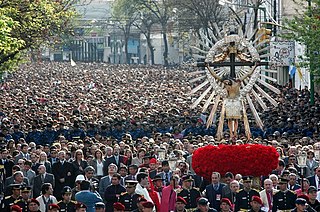
A Holy Week procession is a public ritual march of clergy and penitents which takes place during Holy Week in Christian countries, especially those with a Catholic culture. Various images of the saints, especially the Virgin Mary, and most importantly the image of the crucified Christ are carried aloft by foot on shoulder-borne pasos as an act of penance; acts of mortification are carried out; traditional Christian hymns and chants are sung. In many confraternities of penitents, the faces of the members are covered by elaborate hoods, such as the capirote, as a way of hiding one's identity in order to not ostentatiously draw attention to oneself while performing penance. Crosses, and biers holding Catholic holy images surrounded with flowers and offerings of candles, are carried usually from one parish church to another led by the clergy, monastic orders, or heads of the penitential orders.

Lucena is a Spanish city and municipality, in the province of Córdoba, autonomous community of Andalusia, 60 km southeast of the provincial capital Córdoba. Its circa 42,000 people makes Lucena the second largest municipality in the province after Córdoba. It is located at the conjunction of important highways in the geographical center of Andalusia. People from Lucena are called lucentinos. The city was originally known as Eliossana, etymologically reinterpreted as deriving from the Hebrew אלי הושענא Elí hoshanna, "May God save us". The name in Arabic is اليسانة Al-Yussana.

Tobarra is a municipality in the province of Albacete in Spain, with a population of c. 8,000 as of 2009.
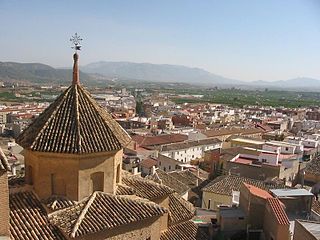
Mula is a municipality of Spain belonging to the Region of Murcia. It is located in southeastern Iberia. It has a total area of 633.84 km2 and, as of 1 January 2020, a registered population of 17,021.
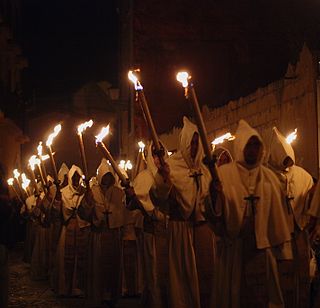
Holy Week in Zamora, Spain, is the annual commemoration of the Passion of Jesus Christ that takes place during the last week of Lent, the week immediately before Easter. Holy Week is the Christian week from Palm Sunday through Easter Sunday. It can take place in March or April. In Zamora, Holy Week is celebrated by 16 Catholic religious brotherhoods and fraternities that perform penance processions on the streets of the city.

Holy Week in Seville is one of two biggest annual festivals in Seville, Andalusia, Spain, the other being the Feria de Abril, which follows two weeks later. It is celebrated in the week leading up to Easter, and features the procession of pasos, floats of lifelike wooden sculptures of individual scenes of sorrowful Mysteries of the Rosary, or images of the grieving Virgin Mary.
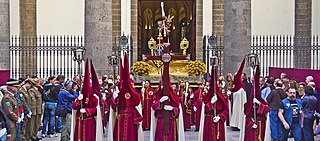
Holy Week in Spain is the annual tribute of the Passion of Jesus Christ celebrated by Catholic religious brotherhoods and fraternities that perform penance processions on the streets of almost every Spanish city and town during the last week of Lent, the week immediately before Easter.
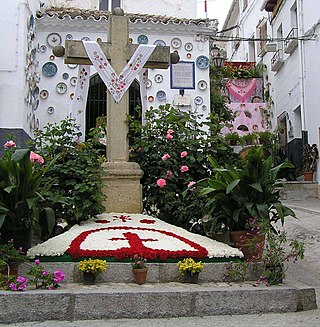
The Fiesta de las Cruces or Cruz de Mayo is a holiday celebrated on 3 May in many parts of Spain and Hispanic America.
The title of Fiesta of International Tourist Interest is an honorary distinction that is given in Spain by the General Secretariat of Tourism of the Ministry of Industry, Tourism and Trade of the Government of Spain to the fiestas or events involving manifestations of cultural and popular tradition, with particular regard to their ethnic characteristics and special importance as tourist attractions. This honorary title is held by 30 fiestas in Spain.

Holy Week in Mexico is an important religious observance as well as important vacation period. It is preceded by several observances such as Lent and Carnival, as well as an observance of a day dedicated to the Virgin of the Sorrows, as well as a Mass marking the abandonment of Jesus by the disciples. Holy Week proper begins on Palm Sunday, with the palms used on this day often woven into intricate designs. In many places processions, Masses and other observances can happen all week, but are most common on , Good Friday, Holy Saturday and Easter Sunday, with just about every community marking the crucifixion of Jesus in some way on Good Friday. Holy Saturday is marked by the Burning of Judas, especially in the center and south of the country, with Easter Sunday usually marked by a Mass as well as the ringing of church bells. Mexico's Holy Week traditions are mostly based on those from Spain, brought over with the Spanish conquest of the Aztec Empire, but observances have developed variations in different parts of the country due to the evangelization process in the colonial period and indigenous influences. Several locations have notable observances related to Holy Week including Iztapalapa in Mexico City, Taxco, San Miguel de Allende and San Luis Potosí.

The Passion Play of Iztapalapa is an annual event during Holy Week in the Iztapalapa borough of Mexico City. It one of the oldest and most elaborate passion plays in Mexico as well as the best known, covered by media both in Mexico and abroad. Unlike others in Latin America, its origins are not in the colonial period but rather in a cholera epidemic in the 19th century, which gave rise to a procession to petition relief. Over time, the procession included a passion play which grew to include various scenes related to Holy Week. Today, the play includes not only hundreds of actors but also thousands of men called “Nazarenes” who carry their own crosses to follow the actor chosen to play Jesus to the site where the crucifixion is reenacted. While the event is still primarily religious, it has also become a rite of identity for Iztapalapa as well as a major tourism attraction for both the borough and the city.

Holy Week in Salamanca is the most important religious event of Salamanca, Spain. It is celebrated in the week leading up to Easter.

The Illustrious Brotherhood of the Holy Cross of the Redeemer and the Immaculate Conception, his Mother, known as the Vera Cruz or True Cross is a Catholic fraternity established in Salamanca, Castile and León, Spain in 1506.

The Illustrious Penitential Brotherhood of Our Lady of Anguish is a Catholic fraternity established in Valladolid, Castile and León, Spain in 1536.
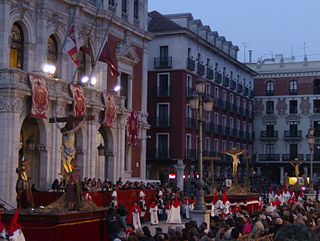
The Holy Week in Valladolid is one of the main tourist attractions, and cultural and religious events of Valladolid and the surrounding province during Holy Week in Spain. It boasts of renowned polychrome sculptures, created mainly by sculptors such as Juan de Juni and Gregorio Fernández, who were active when the city served as the imperial court. The city's National Sculpture Museum has a total of 42 images for the processions. The Holy Week in Valladolid is known to depict the Passion with great fidelity, rigor and detail.

Holy Week in Cuenca (Semana Santa de Cuenca) is the most important religious event of Cuenca, Spain. It is celebrated in the week leading up to Easter (Holy Week among Christians). As a reflection of its cultural, historic and spiritual importance, Holy Week in Cuenca was declared Fiesta of International Tourist Interest of Spain.
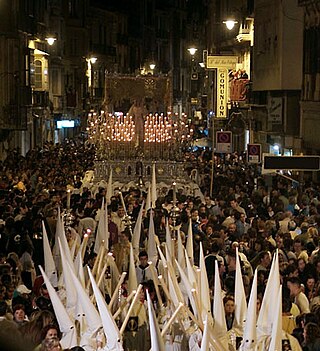
Holy Week in Málaga, is the annual commemoration of the Passion of Jesus in Málaga, Spain. It takes place during the last week of Lent, the week immediately before Easter. It is one of the city's main cultural and religious events.
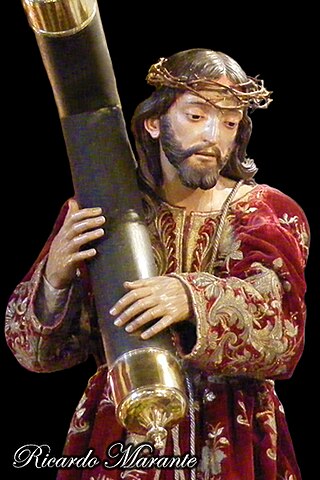
Holy Week is commemorated each year in Santa Cruz de La Palma, Canary Islands, by processions marking the Passion, Death and Resurrection of Jesus Christ. It is one of the oldest festivities in the island of La Palma, and is the most significant public religious event that takes place in the city, except for the Lustral Festivity of the Bajada de la Virgen. In 2014 it was declared a Fiesta of Tourist Interest in the Canary Islands.

Holy Week in San Cristóbal de La Laguna is a traditional event that has been repeated for centuries in the historic center of San Cristóbal de La Laguna, a city located on the island of Tenerife, Spain. It is considered the most remarkable Holy Week in the Canary Islands.



















